The most significant dynamic that shapes the study of International Relations (IR) in Australia is the relationship between the global/theoretical horizons of the discipline and the focus on the Asia-Pacific.
Chart 1 below demonstrates the scale of the Australian study of International Relations, noting particular clusters of scholars at the Australian National University (ANU), Griffith, Monash University, University of Queensland (UQ) and the University of Sydney with additional clusters at Deakin University, Macquarie University, the University of New South Wales (UNSW) and the University of Western Australia (UWA). We can also see a varied distribution on expertise on the Asia-Pacific.

Data for this article comes from the selection of self-labelled IR Departments (except ANU where relevant individuals from Strategic and Defence Studies Centre, Crawford School of Public Policy, and the Asia Pacific College of Diplomacy have been included in the ‘other’ category). The data includes 265 academics at eighteen Australian institutions, from which 112 academics focus on the Asia-Pacific area. Information about area focus is collected from how academics present themselves/are presented on relevant institutional webpages.
It should be noted that focus on Australian foreign policy is classified as separate from an Asia-Pacific focus and is not included in the count of Asia-Pacific regionalists. We recognise that this replicates assumptions about Australia not being part of the Asia-Pacific, but given we are often unable to determine what the particular focus of study is within Australian Foreign Policy, we feel this distinction is worthwhile. This article also presents a snapshot from October 2019 and there are ongoing efforts to build a fuller account of IR expertise beyond IR departments.
The scale of the IR academy in Australia demonstrates a discipline that is in broadly good health in Australia. This scale is supported primarily by what have been to date healthy enrolments in both undergraduate and graduate programs where the study of IR has proven popular with both domestic and international students. Anecdotally it is viewed as more applied and vocational than political science degrees and seen, whether accurately or not, as a clear pathway into both the Australian Public Service and work in various NGOs and IGOs.


60% of the IR academics included in this study note they have a focus on a state or region, and the largest area of study is the Asia-Pacific, with 42% of the reviewed IR community indicating their work lies wholly or partially within the Asia Pacific.
Growing interest in China
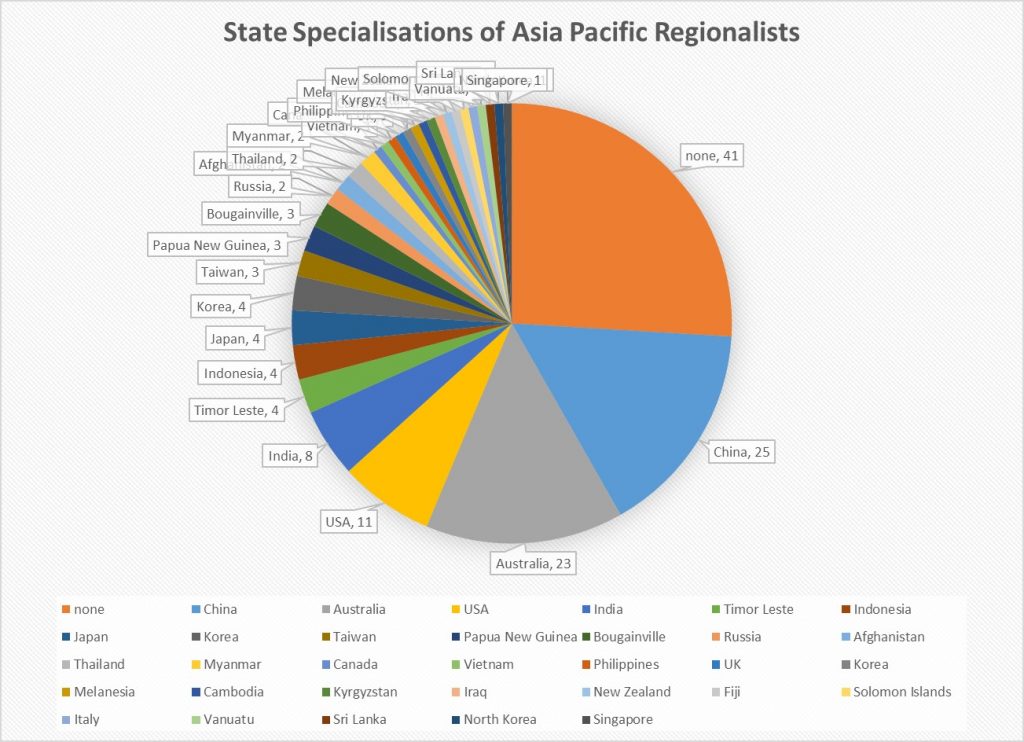
Australian IR has long been interested in great powers and Australia’s relationship with them. It is unsurprising then that the study of China has become the largest single area of focus in Asia-Pacific IR in Australia, and often overlaps with the study of other specific counties (i.e. Australia and China, rather than just Australian foreign policy). This is unsurprising given the growth of Chinese power is the single most significant event facing both the Asia-Pacific and Australia’s own foreign policy.
This is particularly interesting within the discipline as it represents a transfer of power outside of the European/American context. We see evidence of this transfer in the ‘public profile’ of IR Asia-Pacific research where it is commentary on China and East Asian security that dominate the bookshelves. There are questions as to the health/sustainability of areas of study where the community is small or dispersed between institutions.
It is not clear, however, that the growth of the study of China has come at the expense of other areas of research as it has coincided with a general growth of the IR discipline in Australian universities.
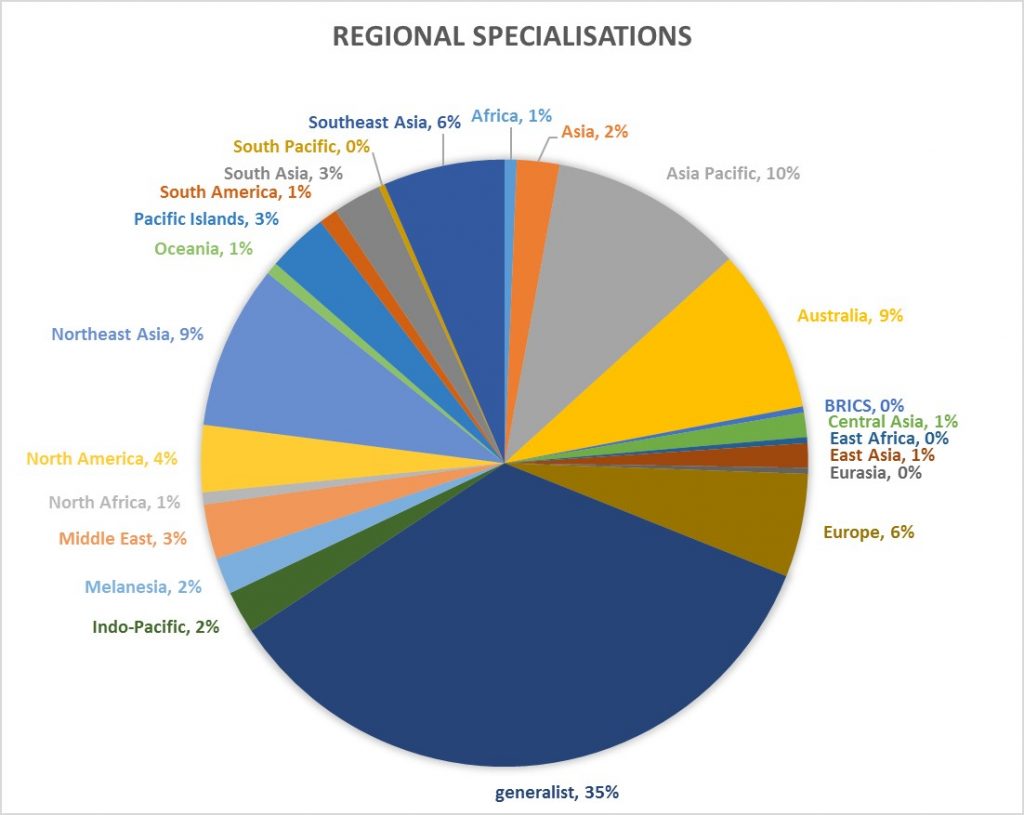
Chart 5 offers a different perspective of the spread of Australian IR, identifying the specific sub- regions that academics discuss. Here we see a broad range of areas of study, although it could be argued that Southeast Asia and the Pacific are comparatively poorly served given their strategic importance to Australia.

Chart 6 focuses attention on the diversity of approaches within the broad study of China within the International Relations. Almost half of IR scholars study Chinese foreign policy from a general perspective, and then with a fair spread of expertise across other dimensions of China’s engagement with the world. This suggests a broad engagement with the role of China in world politics.
Lenses and the study of the Asia-Pacific
Disciplinary IR can be subdivided in numerous ways. One division is between different forms of security lenses – for example, whether scholars study issues in the Asia-Pacific through a hard or soft security agenda. Here we divided hard security as a focus on state security, soft as a focus on human-centric security, and all non-security concerns as ‘other’.
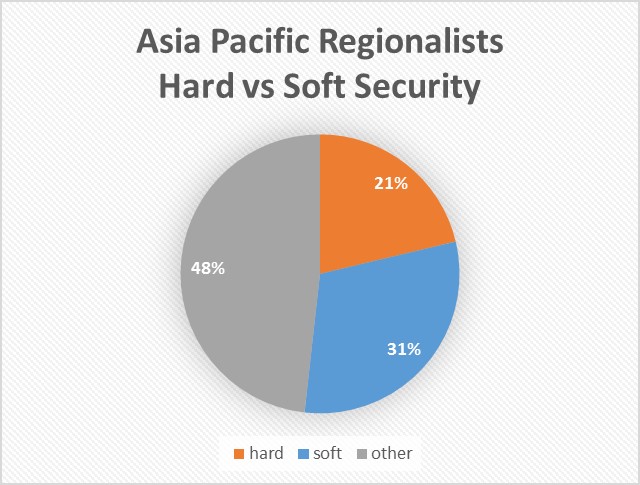
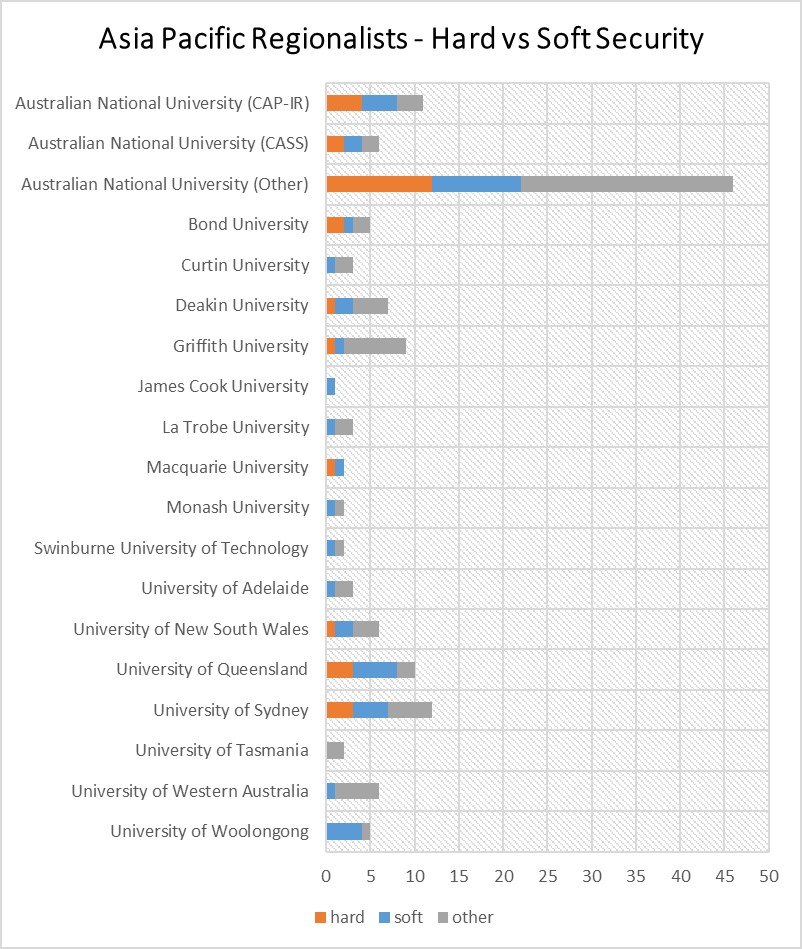
Over half of all who study the Asia-Pacific within IR do so with a security lens, although it is notable that soft/human security perspectives are more numerous than hard security lenses. Asia Pacific security has shifted from a narrow focus on state security and military affairs to a broader engagement with human insecurity and fragility in the face of conflict, reconstruction and climate change. Notable areas of growth have been feminist perspectives on human (in)security, and the growth of the study of the Responsibility to Protect.
The discipline is broadly diverse in method and outlook. The 2014 Teaching, Research and International Policy (TRIP) Survey of Australian IR academics noted 31% were ‘non-positivist’ in epistemological framing, 31% positivist and 38% post-positivist’ (see the TRIP Faculty Survey for information on Australia). The TRIP Survey, run by the Institute for the Theory and Practice of International Relations at William and Mary College in the USA, conducts regular polling of academics worldwide to chart trends.
When considering specific approaches among Australian academics, TRIP reveals the following.
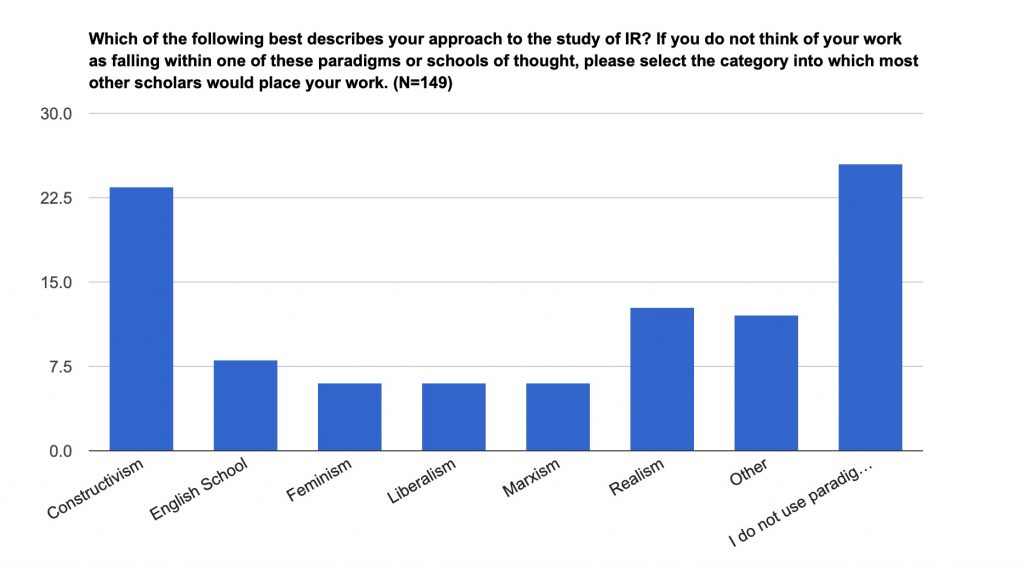
The distribution of theoretical approaches for those focusing on the Asia and Oceania (the TRIP regional category choice) broadly matches the general distribution shown in chart 9.
Future issues and opportunities
We note three issues for consideration when looking to the future. The first is the sustainability of the size of the IR/Asian IR academy in Australia in the face of student enrolment trends and resource scarcity in higher education. This is particularly concerning considering growing concern about over-reliance on particular markets for student enrolments. Whilst at the macro-scale the study of IR is healthy, it is important to note that particular countries, areas of interest and approaches sometimes rest on the shoulders of individuals and small groups, susceptible to disruption in the face of market forces.
Second, we believe Australia has a real opportunity to develop the regional-global/theoretical links in the study of IR. For too long Asia-Pacific issues have been compartmentalised as separate from, perhaps even secondary to, IR’s global concerns (empirically and theoretically centred on the experience of the west). We, and many contemporary scholars in and beyond Australia, reject this. Australia can help, directly and through supporting scholars and scholarship in the wider region, to renew IR both empirically and conceptually, articulating the centrality of the Asia Pacific to the study and practice of world politics.
The third is the degree to which Australian IR (both general and Asia-focused) is dependent on trends and approaches elsewhere, especially the US and to a lesser-extent the UK. Recent trends have sought to dissolve discrete disciplinary boundaries in favour of a far more interdisciplinary approach (such as practices, psychology, emotions). What will Australian IR look like in the face of continued shifts in approach and what role can the study of Asia play in driving forwards these disciplinary trends?
Additional Readings.
There are no studies specifically on Asia and IR in Australia – and we hope to develop this short discussion into a more robust engagement to fill this gap. The following readings discuss the discipline more broadly, including comment on Asia as part of the analysis.
COTTON, J. 2009. Realism, rationalism, race: on the early international relations discipline in Australia. International Studies Quarterly, 53, 627-647.
DEVETAK, R. 2009. An Australian outlook on international affairs? The evolution of international relations theory in Australia. Australian Journal of Politics & History, 55, 335-359.
HALL, I. 2014. The promise and perils of interpretivism in Australian international relations. Australian Journal of Public Administration, 73, 307-316.
HIGGOTT, R. & GEORGE, J. 1990. Tradition and change in the study of international relations in Australia. International Political Science Review, 11, 423-438.
LEE‐KOO, K. 2009. Feminist international relations in Australia. Australian Journal of Politics & History, 55, 415-432.
MORGENBESSER, L. 2013. The 2012 TRIP survey of international relations in Australia: one problem to rule us all. Australian Journal of International Affairs, 67, 218-233.
SHARMAN, J. 2008. Benchmarking Australian IR: low impact, a bookish lot or a very British affair? Australian Journal of International Affairs, 62, 529-540.
SHARMAN, J. & WELLER, P. 2009. Where is the quality? Political science scholarship in Australia. Australian Journal of Political Science, 44, 597-612.
SHARMAN, J. & TRUE, J. 2011. Anglo-American followers or Antipodean iconoclasts? The 2008 TRIP survey of international relations in Australia and New Zealand. Australian Journal of International Affairs, 65, 148-166.
SHARMAN, J. & WELLER, P. 2013. International relations research performance among Australian universities. Australian Journal of International Affairs, 67, 111-117.
WESLEY, M. 2009. The rich tradition of Australian realism. Australian Journal of Politics & History, 55, 324-334.

